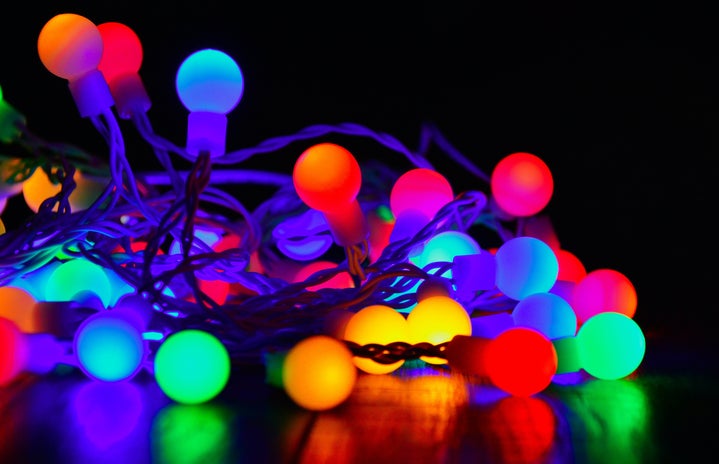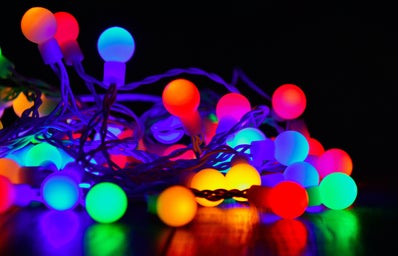Before school started in August, I realized there were some last minute necessities I needed to buy, including a bedside table lamp for my apartment (for weeks, I stumbled and stubbed my toes on my way to my bed at night). Before placing an order for the first lamp I saw on Amazon, I cursorily glanced at the description, noting it touted something about a “color-changing” feature. Recently, I’ve been taking advantage of the supposed effects of colored lights on the body by changing the hues of the light emitted by the lamp.
The effects of color and light on the body have been investigated since 2000 BC, and researchers in each century have postulated that different colored light rays can heal psychological and physiological ailments. This is also known as chromotherapy, defined by the authors of a study published in a medical journal as “the use of the visible spectrum of electromagnetic radiation (colored light) to treat mental and physical diseases.” Twentieth-century researchers contended that each area of the body has energy fields similar to chakras that respond well to different colors. According to this hypothesis, colors can correct chemical imbalances in the body by transferring energy into the body. In 1970, one scientist clinically examined the effects of different colors on the mind and body through projecting light onto people’s skin. His data showed that all colors have psychological and physiological effects on humans. In his study, warm colors were found to increase respiratory movements, frequency of eye blinks, and activation of the cerebral cortex. Warm colors helped stimulate people with depression. On the other hand, cool colors were found to lower blood pressure as well as reduce tension, muscle spasms and frequency of eye blinks. Cool colors made anxious people feel calmer.
Modern medicine utilizes chromotherapy, seen through the use of white light to treat people with seasonal affective disorder and the use of light in the blue-green spectrum to treat neonatal jaundice. However, it is important to note that chromotherapy has not been scientifically proven in peer-reviewed studies to cure mental or physical illnesses.
Chromotherapy is thought to be effective because light is absorbed by photoreceptors in the eyes and then transferred into electrical signals that pass to the hypothalamus. The hypothalamus can stimulate the autonomic nervous system, which controls the activity of body parts such as the intestines, the stomach, blood vessels and salivary glands. The hypothalamus can do this because it receives inputs from the body and has outputs to the pathways of nerve cells, neurons and fibers in the spinal cord that compose the autonomic nervous system.
Cool colors such as green, blue, purple and violet stimulate the anterior hypothalamus, which contains the main regulating part of the parasympathetic nervous system, meaning it outputs to the nerve cells in the spinal cord that make up the parasympathetic nervous system. The parasympathetic nervous system controls the “rest and digest” response. The parasympathetic nervous system contracts blood vessels and muscles, triggers receptors in the heart and lungs, increases the movement of the stomach and intestines, and prompts the liver to produce glucose. This means that exposure to cool colors may lead to maintenance of resting heart rate, decreased blood pressure, muscle relaxation, digestion of food, maintenance of blood sugar levels and production of saliva.
Warm colors such as red, orange and yellow create the opposite response to cool colors. Warm colors stimulate the posterior hypothalamus, which contains the central regulating part of the sympathetic nervous system, meaning it outputs to nerve cells on either side of the spine that make up the sympathetic division. The sympathetic nervous system controls the body’s “fight or flight” response. It constricts blood vessels, prepares the body for physical activity by circulating well-oxygenated blood, decreases movement of the stomach and intestines, diminishes the activity of the pancreases, and lessens secretions in the lungs. This means that exposure to warm colors may increase heart rate, blood pressure, blood flow and air flow in the lungs as well as decelerate digestion and lead to a spike in blood sugar levels.
To gauge how my own body would respond to warm and cool-toned lights, I set my lamp to a red hue when I wanted to energize my body and cue my “fight or flight” response, and I used a violet hue when I sought relaxation and activation of my “rest and digest” response. After a sweaty session on the elliptical, my heart rate was elevated, and I felt jittery. I turned on my lamp and tapped on it a few times until a violet light beamed throughout my apartment. I felt as though I was trapped inside a plum! After nearly thirty minutes, my heart rate decreased, and I felt more relaxed. I might have had this response because I was anticipating that the cool-toned light would activate my parasympathetic nervous system. It is also important to note that memories or previous associations that one has with a color can influence one’s response to it.
I experimented with turning on the red light upon waking up in the morning, optimistic that it would prepare me for the day ahead by increasing my blood flow and heightening my alertness. While the red light that filled my room was so jarring that I had to squint my eyes, I don’t think my lamp will ever replace my morning mug of coffee.
People have diverse backgrounds, different medical histories, varying associations with different colors and particular color preferences, so it is important to emphasize that your response to colored lights will be different than mine and may not align with the effects of warm and cool colors described here. Nevertheless, I recommend that you experiment with using either warm or cool-colored light depending on which division of the autonomic nervous system you want to try to stimulate. During exposure to the light, perhaps do a mindfulness body scan or breathing exercise in order to increase your awareness of how your body is reacting, and be sure to pay attention to your feelings as well. Incorporating a color-changing lamp into your space may en(light)en you with new knowledge of your body and mind. At the very least, you won’t have to wait until it rains to appreciate ROYGBIV.


